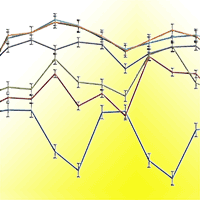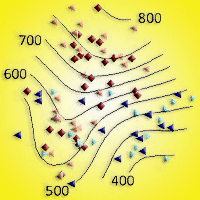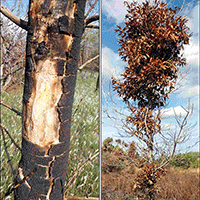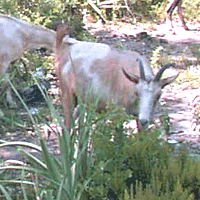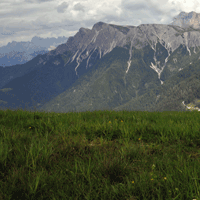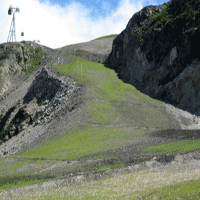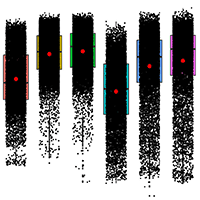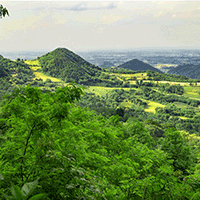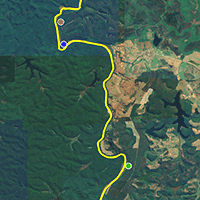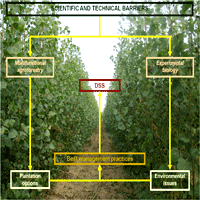The abandonment of pastures often leads to a remarkable deterioration of grasslands, caused by the spread of intrusive, herbaceous and woody species which reduces the general quality of pastures. Different treatments aimed at improving the grassland and enhancing the forage quality of herbaceous resources have been developed to face this problem. We report the results of a five-year experiment conducted in a protected area of central Italy (the “Laghi di Suviana e Brasimone” regional park) on an abandoned pasture inside a beech forest encroached by intrusive species (mainly bracken). We analyzed the effect on sward’s specific composition and grazing value of two agronomic factors: (i) the establishment method (ploughing followed by sowing of a forage mixture versus no intervention), and (ii) the number of cuts performed on vegetation during the growing season (0, 1 or 2 cuts). Plots were arranged according to a split-split-plot experimental design with three replications, with the sampling dates as the main factor, the establishment technique as the subplot factor, and the number of cuts as the sub-subplot factor. In each plot, data were recorded once a month from June to September every year from 2006 to 2010, in order to assess the botanical composition and the quality of the sward. The main pastoral and botanical parameters of pastures were significantly affected by both cutting and sowing. Establishment by sowing significantly reduced the presence of bracken, even with no cuts, with strong effects on the qualitative value of the pasture. A single cut resulted in an efficient recovery of the pasture as compared to cutting twice, especially in sown plots. Our results confirmed that the regular and continued maintenance of the recovered areas is crucial to ensure the long-term preservation of the results achieved by the improvements.
Keywords
, , , ,
Citation
Cervasio F, Argenti G, Genghini M, Ponzetta MP (2016). Agronomic methods for mountain grassland habitat restoration for faunistic purposes in a protected area of the northern Apennines (Italy). iForest 9: 490-496. - doi: 10.3832/ifor1515-008
Academic Editor
Andrea Cutini
Paper history
Received: Nov 30, 2014
Accepted: Sep 02, 2015
First online: Jan 07, 2016
Publication Date: Jun 01, 2016
Publication Time: 4.23 months
© SISEF - The Italian Society of Silviculture and Forest Ecology 2016
Open Access
This article is distributed under the terms of the Creative Commons Attribution-Non Commercial 4.0 International (https://creativecommons.org/licenses/by-nc/4.0/), which permits unrestricted use, distribution, and reproduction in any medium, provided you give appropriate credit to the original author(s) and the source, provide a link to the Creative Commons license, and indicate if changes were made.

Breakdown by View Type
(Waiting for server response...)
Article Usage
Total Article Views: 47252
(from publication date up to now)
Breakdown by View Type
HTML Page Views: 39526
Abstract Page Views: 2533
PDF Downloads: 3880
Citation/Reference Downloads: 22
XML Downloads: 1291
Web Metrics
Days since publication: 3627
Overall contacts: 47252
Avg. contacts per week: 91.19
Article Citations
Article citations are based on data periodically collected from the Clarivate Web of Science web site
(last update: Mar 2025)
Total number of cites (since 2016): 7
Average cites per year: 0.70
Publication Metrics
by Dimensions ©
Articles citing this article
List of the papers citing this article based on CrossRef Cited-by.
(1)
Alday JG, Cox ES, Pakeman RJ, Harris MPK, Le Duc MG, Marrs RH (2012)Overcoming resistance and resilience of an invaded community is necessary for effective restoration: a multi-site bracken control study. Journal of Applied Ecology 50: 156-167.
CrossRef |
Gscholar
(2)
Argenti G, Cervasio F, Ponzetta M (2012)Control of bracken (
Pteridium aquilinum) and feeding preferences in pastures grazed by wild ungulates in an area of the Northern Apennines (Italy). Italian Journal of Animal Science 11: 336-341.
CrossRef |
Gscholar
(3)
Argenti G, Lombardi G (2012)The pasture-type approach for mountain pasture description and management. Italian Journal of Agronomy 7: 293-299.
CrossRef |
Gscholar
(4)
Bagella S, Salis L, Marrosu GM, Rossetti I, Fanni S, Caria MC, Roggero PP (2013)Effects of long-term management practices on grassland plant assemblages in Mediterranean cork oak silvo-pastoral systems. Plant Ecology 214: 621-631.
CrossRef |
Gscholar
(5)
Birch CPD, Vuichard N, Werkman BR (2000)Modelling the effects of patch size on vegetation dynamics: bracken [
Pteridium aquilinum (L.) Kuhn] under grazing. Annals of Botany 85 (Supplement 2): 63-76.
Online |
Gscholar
(6)
Cantiani MG, Talamucci P (1985)Tentativi di controllo della felce
Pteridium aquilinum (L.) Kuhn con interventi “leggeri” in Irpinia. [Control of bracken
Pteridium aquilinum (L.) Kuhn with “light” interventions in Irpinia]. L’Italia Forestale e Montana 40: 337-365. [in Italian]
Gscholar
(7)
Cavallero A, Aceto P, Gorlier A, Lombadi G, Lonati M, Martinasso B, Tagliatori C (2007)I tipi pastorali delle Alpi piemontesi. [Pasture vegetation types in Piedmont Alps]. Alberto Perdisa Editore, Bologna, Italy, pp. 467. [in Italian]
Gscholar
(8)
Cavallero A, Rivoira G, Talamucci P (2002)Pascoli. [Pastures]. In: “Coltivazioni erbacee. Foraggere e tappeti erbosi” (Baldoni R, Giardini L eds). Patron Ed., Bologna, Italy, pp. 239-294. [in Italian]
Gscholar
(9)
Cervasio F (2009)Recupero e valorizzazione della potenzialità pabulare di aree aperte in zone collinari e montane dell’Appennino. [Recovery and valorization of forage quality of open areas in hilly and mountainous environments of Apennines]. PhD thesis, University of Firenze, Firenze, Italy, pp. 84. [in Italian]
Gscholar
(10)
Cervasio F, Ponzetta MP, Argenti G, Di Leo V (2007)Environmental improvement and conservation of useful pastures for wild herbivores in a Regional Park on the Apennine Mountains. Italian Journal of Animal Science 6 (Supplement 1): 842-844.
Gscholar
(11)
Cervasio F, Ponzetta MP, Argenti G, Di Leo V, Crocetti C (2009)Feeding evaluation of spontaneous species used by wild ungulates. Italian Journal of Animal Science 8: 286-288.
CrossRef |
Gscholar
(12)
Cox ES, Marrs RH, Pakeman RJ, Le Duc MG (2007)A multi-site assessment of the effectiveness of
Pteridium aquilinum control in Great Britain. Applied Vegetation Science 10: 429-440.
CrossRef |
Gscholar
(13)
Cox ES, Marrs RH, Pakeman RJ, Le Duc MG (2008)Factors affecting the restoration of heathland and acid grassland on
Pteridium aquilinum infested land across the UK: a multisite study. Restoration Ecology 16: 553-562.
CrossRef |
Gscholar
(14)
Daget P, Poissonet J (1969)Analyse phytologique des prairies. [Phytoecological analysis of grasslands]. CNRS-CEPE doc. no. 50, Montpellier, France, pp. 120. [in French]
Gscholar
(15)
Daget P, Poissonet J (1972)Un procède d’estimation de la valeur pastorale des p’turages. [A method to assess grazing value of pastures]. Fourrages 49: 31-40. [in French]
Gscholar
(16)
Den Ouden J (2000)The role of bracken (
Pteridium aquilinum) in forest dynamics. PhD thesis, University of Wageningen, Wageningen, The Netherlands, pp. 218.
Online |
Gscholar
(17)
Di Tomaso JM, Masters RA, Peterson VF (2010)Rangeland invasive plant management. Rangeland 32: 43-47.
CrossRef |
Gscholar
(18)
Doležal J, Mašková Z, Lepš J, Steinbachová D, De Bello F, Klimešová J, Tackenberg O, Zemeke F, Kvtc J (2011)Positive longterm effect of mulching on species and functional trait diversity in a nutrient-poor mountain meadow in Central Europe. Agriculture, Ecosystems and Environment 145: 10-28.
CrossRef |
Gscholar
(19)
Frankland JC (1976)Decomposition of bracken litter. Botanical Journal of the Linnean Society 73: 133-143.
CrossRef |
Gscholar
(20)
Genghini M, Capizzi D (2005)Habitat improvement and effects on brown hare
Lepus europaeus and roe deer
Capreolus capreolus: a case study in northern Italy. Wildlife Biology 11: 319-329.
CrossRef |
Gscholar
(21)
Godefroid S, Monbaliu D, Massant W, Van Der Aa B, De Vos B, Quivyc V, Koedam N (2007)Effects of soil mechanical treatments combined with bramble and bracken control on the restoration of degraded understory in an ancient beech forest. Annals of Forest Science 64: 321-331.
CrossRef |
Gscholar
(22)
Gomez KA, Gomez AA (1984)Statistical procedures in agricultural research (2nd edn). John Wiley and Sons, New York, USA, pp. 680.
Gscholar
(23)
Laiolo P, Pondero F, Ciliento E, Rolando A (2004)Consequences of pastoral abandonment for the structure and diversity of the alpine avifauna. Journal of Applied Ecology 41: 294-304.
CrossRef |
Gscholar
(24)
Le Duc MG, Pakeman RJ, Marrs RH (2000a)Vegetation development on upland and marginal land treated with herbicide for bracken (
Pteridium aquilinum) control in Great Britain. Journal of Environmental Management 58: 147-160.
CrossRef |
Gscholar
(25)
Le Duc MG, Pakeman RJ, Putwain PD, Marrs RH (2000b)The variable responses of bracken fronds to control treatments in Great Britain. Annals of Botany 85: 17-29.
CrossRef |
Gscholar
(26)
Le Duc MG, Pakeman RJ, Marrs RH (2003)Changes in the bracken rhizome system subjected to long-term experimental treatment. Journal of Applied Ecology 40: 508-522.
CrossRef |
Gscholar
(27)
Lengyel S, Déri E, Varga Z, Horváth R, Tóthmérész B, Henry PY, Kobler A, Kutnar L, Babij V, Selinkar A, Christia C, Papastergiadou E, Gruber B, Henle K (2008)Habitat monitoring in Europe: a description of current practices. Biodiversity and Conservation 17: 3327-3339.
CrossRef |
Gscholar
(28)
Lowday JE, Marrs RH (1992)Control of bracken and the restoration of heathland. III. Bracken litter disturbance and heathland restoration. Journal of Applied Ecology 29: 212-217.
CrossRef |
Gscholar
(29)
Mack R, Simberloff D, Lonsdale W, Evans H, Clout M, Bazzaz F (2000)Biotic invasions: causes, epidemiology, global consequences, and control. Ecological Applications 10: 689-710.
CrossRef |
Gscholar
(30)
Marrs RH, Lowday JE, Jarvis L, Gough MW, Rowland AP (1992)Control of bracken and the restoration of heathland. IV. Effects of bracken control and heathland restoration treatments on nutrient distribution and soil chemistry. Journal of Applied Ecology 29: 218-225.
CrossRef |
Gscholar
(31)
Marrs RH, Le Duc MG, Mitchell R, Goddard D, Paterson S, Pakeman R (2000)The ecology of bracken: its role in succession and implications for control. Annals of Botany 85 (Suppl. B): 3-15.
CrossRef |
Gscholar
(32)
Marrs RH, Watt A (2006)Biological flora of
Pteridium aquilinum (L.) Kuhn. Journal of Ecology 94: 1272-1322.
CrossRef |
Gscholar
(33)
McAllister MM, Schooley RL, Bestelmeyer BT, Coffman JM, Cosentino BJ (2014)Effects of grassland restoration efforts on mound-building ants in the Chihuahuan Desert. Journal of Arid Environments 111: 79-83.
CrossRef |
Gscholar
(34)
Messeri A, Ponzetta MP, Cervasio F, Crocetti C, Gori L, Argenti G (2010)Habitat improvements with agronomic treatments for ungulates in an area of central Italy. In: Proceedings of the “23th General Meeting of European Grassland Federation” (Schnyder H et al eds). Kiel (Germany), 29 Aug-2 Sep 2010. Mecke Druck und Verlag, Duderstadt, Germany, pp. 767-769.
Online |
Gscholar
(35)
Pakeman RJ, Le Duc MG, Marrs RH (2002)A review of current bracken control and associated vegetation strategies in Great Britain. Web Ecology 3: 6-11.
CrossRef |
Gscholar
(36)
Pakeman RJ, Marrs RH (1992)The conservation value of bracken
Pteridium aquilinum (L.) Kuhn dominated communities in the UK, and an assessment of the ecological impact of bracken expansion and removal. Biological Conservation 62: 101-114.
CrossRef |
Gscholar
(37)
Peeters A (2008)Challenges for grasslands, grassland-based systems and their production potential in Europe. In: Proceedings of the “22th General Meeting of European Grassland Federation” (Hopkins et al. eds). Uppsala (Sweden), 9-12 June 2008. SLU Repro, Sweden, pp. 9-24.
Online |
Gscholar
(38)
Pienkowski MW, Watkinson AR, Kerby G, Marrs RH, Johnson SW, Le Duc MG (1998)Control of bracken and restoration of heathland. VI. The response of bracken fronds to 18 years of continued bracken control or 6 years of control followed by recovery. Journal of Applied Ecology 35: 479-490.
CrossRef |
Gscholar
(39)
Ponzetta MP, Cervasio F, Crocetti C, Messeri A, Argenti G (2010)Habitat improvements with wildlife purposes in a grazed area on the Apennine Mountains. Italian Journal of Agronomy 5: 233-238.
CrossRef |
Gscholar
(40)
Prach K, Jongepierová I, Rehounková K, Fajmon K (2014)Restoration of grasslands on ex-arable land using regional and commercial seed mixtures and spontaneous succession: successional trajectories and changes in species richness. Agriculture, Ecosystems and Environment 182: 131-136.
CrossRef |
Gscholar
(41)
Roggero PP, Bagella S, Farina R (2002)Un archivio di dati di indici specifici per la valutazione integrata del valore pastorale. [Integrated analysis to assess the grazing value of Mediterranean rangelands]. Rivista di Agronomia 36: 149-156. [in Italian]
Gscholar
(42)
Rook AJ, Tallowin JRB (2003)Grazing and pasture management for biodiversity benefit. Animal Research 52: 181-189.
CrossRef |
Gscholar
(43)
Rossetti I, Bagella S, Cappai C, Caria MC, Lai R, Roggero PP, Martins Da Silva P, Sousa JP, Querner P, Seddaiu G, (2015)Isolated cork oak trees affect soil properties and biodiversity in a Mediterranean wooded grassland. Agriculture, Ecosystems and Environment 202: 203-216.
CrossRef |
Gscholar
(44)
SAS (2003)SAS/STAT software. Release 9.1, SAS Institute Inc., Cary, NC, USA, pp. 5121.
Gscholar
(45)
Smart RP, Calver LJ, Crowe AM, Emmerson KM, Cresser MS (2007)Bracken effects on inorganic nitrogen leaching from an upland podzol. Soil Use and Management 23: 317-322.
CrossRef |
Gscholar
(46)
Stevens R (2004)Basic considerations for range and wildland revegetation and restoration. General Technical Report RMRS-GTR-136, Chapter 4, Rocky Mountain Research Station, USDA Forest Service, Fort Collins, CO, USA, pp. 19-23.
Online |
Gscholar
(47)
Stewart G, Cox E, Le Duc MG, Pakeman R, Pullin A, Marrs RH (2008)Control of
Pteridium aquilinum: meta-analysis of a multi-site study in the UK. Annals of Botany 101: 957-970.
CrossRef |
Gscholar
(48)
Stewart G, Pullin A, Tyler C (2007)The effectiveness of asulam for bracken (
Pteridium aquilinum) control in the United Kingdom: a meta-analysis. Environmental Management 40: 747-760.
CrossRef |
Gscholar
(49)
Targetti S, Staglianò N, Messeri A, Argenti G (2010)A state-and-transition approach to alpine grasslands under abandonment. iForest - Biogeosciences and Forestry 3: 44-51.
CrossRef |
Gscholar
(50)
Tocco C, Probo M, Lonati M, Lombardi G, Negro M, Nervo B, Rolando A, Palestrini C (2013)Pastoral practices to reverse shrub encroachment of sub-alpine grasslands: dung beetles (coleoptera, scarabaeoidea) respond more quickly than vegetation. PLoS ONE 8 (12): e83344.
CrossRef |
Gscholar
(51)
Ward LK, Jennings RD (1990)Succession of disturbed and undisturbed chalk grassland at Aston Rowant National Nature Reserve: details of changes in species. Journal of Applied Ecology 27: 913-923.
CrossRef |
Gscholar
(52)
Wilsey BJ, Martin LM (2015)Top-down control of rare species abundances by native ungulates in a grassland restoration. Restoration Ecology 23: 465-472.
CrossRef |
Gscholar
(53)
Zechmeister HG, Schmitzberger I, Steurer B, Peterseil J, Wrbka T (2003)The influence of land-use practices and economics on plant species richness in meadows. Biological Conservation 114: 165-177.
CrossRef |
Gscholar
